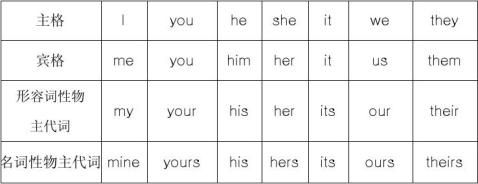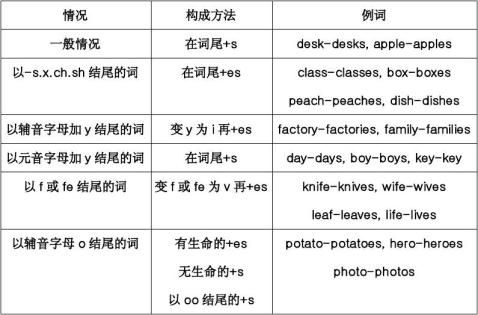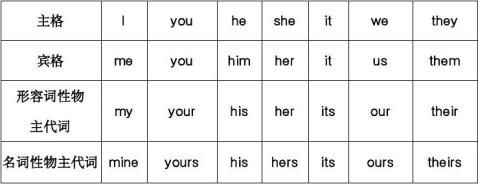小学英语时态总结1
一般现在时
标志词:always(总是) usually(通常) often(经常) sometimes(有时) never(从不) every(每一)
一般现在时动词只有第三人称单数(he,she,it或my cousin,my mother等等)有词形变化,
其他人称(第一人称:I, we;第二人称:you;第三人称复数:they、my friends)动词均用原形
当主语是第三人称单数(he,she,it或my cousin,my mother等等)时,一般动词在一般现在时句子中的变化规律:
1、多数在动词后加s play—plays like—likes ,
2、以s,x,sh,ch,o结尾的动词加es wash–washes catch–catches do–does
3、以辅音字母加y结尾,把y改i再加es fly—flies study—studies
4、以元音字母加y结尾,直接加s buy – buys
5、不规则变化 have—has
一般现在时基本用法
功能
1.表示事物或人物的特征、状态。 如:The sky is blue.天空是蓝色的。
2.表示经常性或习惯性的动作。 如:I get up at six every day.我每天六点起床。
3.表示客观现实。 如:The earth goes around the sun.地球绕着太阳转。
The earth is round.
构成
1. be动词:主语+be(am,is,are)+其它。 如:I am a boy.我是一个男孩。
2.行为动词:主语+行为动词+其它)。 如:We study English.我们学习英语。 句型
肯定句:A.be动词:主语+ be + 其它成分 He is a worker.
B.行为动词:主语+动词(注意人称变化) +其它成分 We like the little cat.
否定句:A.be动词:主语+ be + not +其它成分 They are not students.
B.行为动词:主语+助动词(do/does) + not +动词原形+其它成
分We don’t like the little cat.
1
一般疑问句:A.be动词: Am / Is /Are +主语 + 其它成分
Are you a teacher? Yes, I am. / No, I am not.
Are they students of your school.Yes they are / No they aren,t.
B.行为动词:助动词(Do/Does)+主语+动词原形 + 其它成分
Do you like it? Yes, I do. / No. I don’t .
Does he(she) like it? Yes, he( she )does. / No, he ( she )doesn’t.
特殊疑问句:疑问词+ 一般疑问句
A.be动词: How many students are there in your school?
B.行为动词:What do you usually do on Sunday?
一般现在时动词be和 have的变化形式
1.动词Be 叫连系动词, 用法:第一人称单数(I)用am,第三人称单数(he,she,it或my cousin,my mother等等)用is,其它人称用are。
2.动词have的用法:第三人称单数(he,she,it或my cousin,my mother等等)用has以外,其它人称一律用have。
现在进行时:
标志词:now, look, listen,It’s+时间.
现在进行时: 表示正在进行的、发生的动作
基本结构:
am 动词 ing
are
肯定句:主语 + be动词(am, are, is)+ 现在分词(ing)+ 其他 I am watching TV.
否定句:主语 + be动词+ not + 现在分词(ing)+ 其他 I am not watching TV.
一般疑问句:Be动词(Am, Are, Is) + 主语 + 现在分词(ing)+ 其他
Are you watching TV? Yes, I am. / No, I am not.
2
特殊疑问句: 疑问词+ 一般疑问句
What are you doing?
动词的-ing形式的变化规律:
1. 直接加-ing watch—watching clean—cleaning
2. 以-y结尾的动词,直接加-ing study—studying play—playing
3. 以不发音的-e结尾的动词,先去-e再加-ing make—making come—coming
4. 末尾只有一个元音字母和一个辅音字母的重读闭音节动词,
双写末尾字母,再加-ing cut—cutting
一般将来时的用法:
表示将来某一时刻的动作或状态,或将来某一段时间内经常的动作或状态。
标志词:tomorrow(明天),the day after tomorrow(后天),next (下一个),
from now on(从现在开始),in the future(将来),soon(不久)等
结构:( 1 ) be(am,is ,are) +going to+动词原形 ( 2 ) will+动词原形
“be going to+动词原形(打算?)”=”will+动词原形(将,会?)”
I’m going to study tomorrow. I will study tomorrow.
(be going to着重于事先考虑好 will 未事先考虑好)----一般不用考虑
肯定句:主语 + be (am, are, is) going to + 动词原形.
主语 + will + 动词原形
否定句:主语 + be (am, are, is) not going to + 动词原形.
主语 + won’t + 动词原形.
一般疑问句:Be (Am, Are, Is) + 主语 + going to + 动词原形?
Will + 主语 + 动词原形?
特殊疑问句:疑问词+ 一般疑问句?
注意:will 常简略为 'll,并与主语连写在一起,如:I'll,he'll,it'll,we'll,you'll,they'll。
一般过去时
标志词:yesterday(昨天), last (上一个), this morning(今天早上),ago(以前),
before (在?之前), in 2002(在20xx年) 等
用法:表示过去某个时间发生的动作或存在的状态,常和表示过去的时间状语连用。
也表示过去经常或反复发生的动作
3
动词过去式变化规则:
1.一般在动词末尾加-ed 如:watch-watched, cook-cooked
2.结尾是e加d 如:taste-tasted
3.末尾只有一个元音字母和一个辅音字母的重读闭音节,应双写末尾的辅音字母,再加-ed,如:stop-stopped
4.以“辅音字母+y”结尾的,变y为i, 再加-ed,如:study-studied
5.不规则动词过去式:am,is-was, are-were, do-did, see-saw, say-said, give-gave…
句型:
1、Be动词在一般过去时中的变化:
⑴am 和is 变为was。 否定(was not=wasn’t)
⑵are 变为were。 否定(were not=weren’t)
否定句:在 was或were后加not
一般疑问句:把was或were调到句首。
2、行为动词在一般过去时中的变化
否定句:didn’t + 动词原形 如:Jim didn’t go home yesterday.
一般疑问句:在句首加Did,句子中的动词过去式变回原形 如:Did Jim go home yesterday?
特殊疑问句:(1)疑问词+did+主语+动词原形? 如: What did Jim do yesterday?
(2)疑问词当主语时:疑问词+动词过去式? 如:Who went to home yesterday?
情态动词
情态动词的定义:情态动词有词义,但它不能单独作谓语,它必须和其他动词一起构成谓语。
情态动词没有人称和数的变化,后加动词原形。
can 能够,会 may 可以 shall 将,要 should 应该 must 必须
have(has)to 不得不 had better 最好
情态动词的用法
4
:
情态动词 can may shall should must have(has)to
肯定句
主语 + can + 动词原形 主语 + may + 动词原形 主语 + shall + 动词原形 主语 + should + 动词原形 主语 + must + 动词原形 主语 + have(has)to
+ 动词原形
否定句
主语 + can + not + 动词原形 主语 + may + not + 动词原形 主语 + shall + not + 动词原形 主语 + should + not + 动词原形 主语 + must + not + 动词原形 主语 + don’t(doesn’t)+ have(has)to + 动词原形
情态动词 can may shall should must have(has)to
疑问句
Can + 主语+动词原形? May + 主语+动词原形? Shall + 主语+动词原形? Should +主语+动词原形? Must + 主语+动词原形? Do (does)+主语 + have to +动词原形?
肯定回答 Yes, ~ can. Yes, ~ may. / Sure. Yes, please. / All right.
Yes, ~ should. Yes, ~ must. Yes, ~ do (does).
否定回答 No, ~ can’t. No, ~ may not. No, let’s not. No, ~ shouldn’t. No, ~ needn’t. No, ~don’t (doesn’t).
名词复数规则
1.一般情况下,直接加-s,如:book-books, bag-bags, cat-cats, bed-beds
2.以s. x. sh. ch结尾,加-es,如:bus-buses, box-boxes, brush-brushes, watch-watches
3.以“辅音字母+y”结尾,变y为i, 再加-es,如:family-families, strawberry-strawberries 4.以“f或fe”结尾,变f或fe为v, 再加-es,如:knife-knives
5
5.不规则名词复数:man-men, woman-women,
policeman-policemen, policewoman-policewomen, mouse-mice, child-children,foot-feet,
tooth-teeth,fish-fish, people-people, Chinese-Chinese,
Japanese-Japanese
可数名词变为复数形式有如下变化,如下表:

技巧归纳
改f(e)为ve加s口诀
(1)树叶半数自己黄 妻子拿刀去割粮 架后窜出一只狼 就像小偷逃命忙
(2)常用不规则名词复数形式 foot-feet 脚 man-men 男人 woman-women 女人 tooth-teeth 牙 mouse-mice 老鼠 goose-geese 鹅 child-children 小孩
(3)单复数同形 fish 鱼 li 里 jin 斤 yuan 元 mu 亩 sheep 羊 deer 小鹿 Chinese 中国人 Japanese 日本人 means 手段
高频考点 man woman 作定词修饰复数时需变为复数形式
two men doctors 两位男医生 many women leaders 很多女领导
(4)只有复数形式,没有单数形式
trousers 裤子 clothes 衣服 shorts 短裤 goods 商品 glasses 眼镜 shoes 鞋
(5)常用不可数名词
advice 建议 baggage 行李 bread 面包 rain 雨 steel 钢 gold 金
sand 沙 grass 草 glass 玻璃 oil 油 paper 纸 butter 黄油
salt 盐 beauty 漂亮 change 零钱 information 信息 smoke water 水 homework 作业 cloth 布 food 食品 money 钱 tea 茶 snow 雪
wealth 财富 furniture 家具 cotton 棉花 rice 大米 fruit 水果 milk 牛奶
6
代词的用法.

主格:一般放在句子前,做主语. ?
宾格:一般放在动词,介词(for、to、of?)后.
形容词性物主代词:修饰名词,放在名词前.?
名词性物主代词:代表名词,后不跟名词.
There be 有,表示存在。
There is+单数、不可数名词 There are+复数 “There be” 句型结构:
肯定句: “ There be+ 主语(某人 / 某物)+ 某地 There isa boy in the room.
否定句: “There be + not (any)+ 主语 + 某地 There aren't any books on the desk. 一般疑问句:“Be(is、are) there +(any)+ 主语 + 某地 “Yes , there is / are.” “No, there isn't / aren't. ”
介词口诀:
介词的用法
In +早、午、晚, At +点与分。
in+年、月、年月、季节、周
特定日子、日期、年月日,星期加上早、午、晚on, on +早、午、晚+ of + 年、月、日 by+交通工具
this、that、tomorrow,yesterday,next、last、one。 接年、月、季、星期、周,介词省略。
7
8
第二篇:小学英语时态总结1
一般现在时
标志词:always(总是) usually(通常) often(经常) sometimes(有时) never(从不) every(每一) 一般现在时动词只有第三人称单数(he,she,it或my cousin,my mother等等)有词形变化,
其他人称(第一人称:I, we;第二人称:you;第三人称复数:they、my friends)动词均用原形
当主语是第三人称单数(he,she,it或my cousin,my mother等等)时,一般动词在一般现在时句子中的变化规律:
1、多数在动词后加s play—plays like—likes ,
2、以s,x,sh,ch,o结尾的动词加es wash–washes catch–catches do–does
3、以辅音字母加y结尾,把y改i再加es fly—flies study—studies
4、以元音字母加y结尾,直接加s buy – buys
5、不规则变化 have—has
一般现在时基本用法
功能
1.表示事物或人物的特征、状态。 如:The sky is blue.天空是蓝色的。
2.表示经常性或习惯性的动作。 如:I get up at six every day.我每天六点起床。
3.表示客观现实。 如:The earth goes around the sun.地球绕着太阳转。 The earth is round.
构成
1. be动词:主语+be(am,is,are)+其它。 如:I am a boy.我是一个男孩。
2.行为动词:主语+行为动词+其它)。 如:We study English.我们学习英语。
1
句型
肯定句:A.be动词:主语+ be + 其它成分 He is a worker.
B.行为动词:主语+动词(注意人称变化) +其它成分 We like the little cat.
否定句:A.be动词:主语+ be + not +其它成分 They are not students.
B.行为动词:主语+助动词(do/does) + not +动词原形+其它成分
We don’t like the little cat.
一般疑问句:A.be动词: Am / Is /Are +主语 + 其它成分
Are you a teacher? Yes, I am. / No, I am not.
Are they students of your school.Yes they are / No they aren,t.
B.行为动词:助动词(Do/Does)+主语+动词原形 + 其它成分
Do you like it? Yes, I do. / No. I don’t .
Does he(she) like it? Yes, he( she )does. / No, he ( she )doesn’t.
特殊疑问句:疑问词+ 一般疑问句
A.be动词: How many students are there in your school?
B.行为动词:What do you usually do on Sunday?
一般现在时动词be和 have的变化形式
1.动词Be 叫连系动词, 用法:第一人称单数(I)用am,第三人称单数(he,she,it或my cousin,my mother等等)用is,其它人称用are。
2.动词have的用法:第三人称单数(he,she,it或my cousin,my mother等等)用has以
2
外,其它人称一律用have。
现在进行时:
标志词:now, look, listen,It’s+时间.
现在进行时: 表示正在进行的、发生的动作
基本结构:
am be is + 动词 ing
are
肯定句:主语 + be动词(am, are, is)+ 现在分词(ing)+ 其他 I am watching TV. 否定句:主语 + be动词+ not + 现在分词(ing)+ 其他
I am not watching TV.
一般疑问句:Be动词(Am, Are, Is) + 主语 + 现在分词(ing)+ 其他
Are you watching TV? Yes, I am. / No, I am not.
特殊疑问句:疑问词+ 一般疑问句
What are you doing?
动词的-ing形式的变化规律:
1. 直接加-ing watch—watching clean—cleaning
2. 以-y结尾的动词,直接加-ing study—studying play—playing
3. 以不发音的-e结尾的动词,先去-e再加-ing
make—making come—coming
3
4. 末尾只有一个元音字母和一个辅音字母的重读闭音节动词,
双写末尾字母,再加-ing cut—cutting
一般将来时的用法:
表示将来某一时刻的动作或状态,或将来某一段时间内经常的动作或状态。
标志词:tomorrow(明天),the day after tomorrow(后天),next (下一个),from now on(从现在开始),in the future(将来),soon(不久)等
结构:( 1 ) be(am,is ,are) +going to+动词原形 ( 2 ) will+动词原形
“be going to+动词原形(打算…)”=”will+动词原形(将,会…)”
I’m going to study tomorrow. I will study tomorrow.
(be going to着重于事先考虑好 will 未事先考虑好)----一般不用考虑
肯定句:主语 + be (am, are, is) going to + 动词原形.
主语 + will + 动词原形
否定句:主语 + be (am, are, is) not going to + 动词原形.
主语 + won’t + 动词原形.
一般疑问句:Be (Am, Are, Is) + 主语 + going to + 动词原形?
Will + 主语 + 动词原形?
4
特殊疑问句:疑问词+ 一般疑问句?
注意:will 常简略为 'll,并与主语连写在一起,如:I'll,he'll,it'll,we'll,you'll,they'll。
一般过去时
标志词:yesterday(昨天), last (上一个), this morning(今天早上),ago(以前),
before (在?之前), in 2002(在20xx年) 等
用法:表示过去某个时间发生的动作或存在的状态,常和表示过去的时间状语连用。
也表示过去经常或反复发生的动作
动词过去式变化规则:
1.一般在动词末尾加-ed 如:watch-watched, cook-cooked
2.结尾是e加d 如:taste-tasted
5
3.末尾只有一个元音字母和一个辅音字母的重读闭音节,应双写末尾的辅音字母,再加-ed,如:stop-stopped
4.以“辅音字母+y”结尾的,变y为i, 再加-ed,如:study-studied
5.不规则动词过去式:am,is-was, are-were, do-did, see-saw, say-said, give-gave…
句型:
1、Be动词在一般过去时中的变化:
⑴am 和is 变为was。 否定(was not=wasn’t)
⑵are 变为were。 否定(were not=weren’t)
否定句:在 was或were后加not
一般疑问句:把was或were调到句首。
2、行为动词在一般过去时中的变化
否定句:didn’t + 动词原形 如:Jim didn’t go home yesterday.
一般疑问句:在句首加Did,句子中的动词过去式变回原形 如:Did Jim go home yesterday?
特殊疑问句:(1)疑问词+did+主语+动词原形? 如: What did Jim do yesterday?
(2)疑问词当主语时:疑问词+动词过去式? 如:Who went to home
yesterday?
6
情态动词
情态动词的定义:情态动词有词义,但它不能单独作谓语,它必须和其他动词一起构成谓语。 情态动词没有人称和数的变化,后加动词原形。
can 能够,会 may 可以 shall 将,要 should 应该 must 必须 have(has)to 不得不 had better 最好
情态动词的用法:
情态动词
can
may
shall
should
must
肯定句 主语 + can + 动词原形 主语 + may + 动词原形 主语 + shall + 动词原形 主语 + should + 动词原形 主语 + must + 动词原形 否定句 主语 + can + not + 动词原形 主语 + may + not + 动词原形 主语 + shall + not + 动词原形 主语 + should + not + 动词原形 主语 + must + not + 动词原形 7
have(has)totot 主语 + have(has)to
+ 动词原形
情态动词 疑问句 主语 + don’t(doesn’t)+ have(has)to + 动词原形 肯定回答
Yes, ~ can. 否定回答 No, ~ can’t. Can Can + 主语+动词原形?
may
shall
should
must May + 主语+动词原形? Yes, ~ may. / Sure. No, ~ may not. Shall + 主语+动词原形Yes, please. / All right. ? Should +主语+动词原形? Yes, ~ should. Must + 主语+动词原形? Yes, ~ must. No, let’s not. No, ~ shouldn’t. No, ~ needn’t.
have(has)to Do (does)+主语 + Yes, ~ do (does). No, ~don’t (doesn’t).
have to +动词原形?
名词复数规则
1.一般情况下,直接加-s,如:book-books, bag-bags, cat-cats, bed-beds
2.以s. x. sh. ch结尾,加-es,如:bus-buses, box-boxes, brush-brushes, watch-watches
3.以“辅音字母+y”结尾,变y为i, 再加-es,如:family-families, strawberry-strawberries
4.以“f或fe”结尾,变f或fe为v, 再加-es,如:knife-knives
5.不规则名词复数:man-men, woman-women, policeman-policemen,
policewoman-policewomen, mouse-mice, child-children,foot-feet,
tooth-teeth,fish-fish, people-people, Chinese-Chinese, Japanese-Japanese
8
可数名词变为复数形式有如下变化,如下表:

技巧归纳a
改f(e)为ve加s口诀
(1)树叶半数自己黄 妻子拿刀去割粮 架后窜出一只狼 就像小偷逃命忙
(2)常用不规则名词复数形式 foot-feet 脚 man-men 男人
woman-women 女人 tooth-teeth 牙 mouse-mice 老鼠
goose-geese 鹅 child-children 小孩
(3)单复数同形 fish 鱼 li 里 jin 斤 yuan 元 mu 亩 sheep 羊 deer 小鹿 Chinese 中国人 Japanese 日本人 means 手段 高频考点 man woman 作定词修饰复数时需变为复数形式
9
two men doctors 两位男医生 many women leaders 很多女领导
(4)只有复数形式,没有单数形式
trousers 裤子 clothes 衣服 shorts 短裤 goods 商品 glasses 眼镜 shoes 鞋
(5)常用不可数名词
advice 建议 baggage 行李 bread 面包 rain 雨 steel 钢 gold 金 sand 沙 grass 草 glass 玻璃 oil 油 paper 纸 butter 黄油
salt 盐 beauty 漂亮 change 零钱 information 信息 smoke water 水 homework 作业 cloth 布 food 食品 money 钱 tea 茶 snow 雪 wealth 财富 furniture 家具 cotton 棉花 rice 大米 fruit 水果 milk 牛奶

10
主格:一般放在句子前,做主语. ?
宾格:一般放在动词,介词(for、to、of…)后.
形容词性物主代词:修饰名词,放在名词前.?
名词性物主代词:代表名词,后不跟名词.
There be 有,表示存在。
There is+单数、不可数名词 There are+复数
“There be” 句型结构:
肯定句: “ There be+ 主语(某人 / 某物)+ 某地 There isa boy in the room.
否定句: “There be + not (any)+ 主语 + 某地 There aren't any books on the desk. 一般疑问句:“Be(is、are) there +(any)+ 主语 + 某地
“Yes , there is / are.” “No, there isn't / aren't. ”
介词口诀:
介词的用法
In +早、午、晚,
At +点与分。
in+年、月、年月、季节、周
特定日子、日期、年月日,星期加上早、午、晚on,
11
on +早、午、晚+ of + 年、月、日
by+交通工具
this、that、tomorrow,yesterday,next、last、one。 接年、月、季、星期、周,介词省略。
12
13
-
PEP小学英语时态总结
小学英语时态小结一、一般现在时:用来叙述经常性发生的事情、习惯和爱好等,时间词有:sometimes\often\usually\…
-
小学英语时态总结
一般现在时标志词:always(总是)usually(通常)often(经常)sometimes(有时)never(从不)ever…
-
小学英语时态总结
一般过去时一般过去时:表示过去某个时间发生的动作或存在的状态,也表示过去经常或反复发生的动作。构成:主+动词过去式+其他….关键词…
-
小学英语时态总结
一、时态小结凡是在must,mustn’t,can,can’t,let’s,don’t,may,will后的一定要用动词的原形二、…
-
小学英语时态总结与练习
一、一般现在时:【No.1】一般现在时的功能1.表示事物或人物的特征、状态。如:Theskyisblue.天空是蓝色的。2.表示经…
-
小学英语工作总结
小学英语学期教学工作总结眨眼之间,一个学期过去了,总的来说,我在这个学校已经工作了两年多了,由当初的学生真正的演变到现在的老师,的…
-
小学英语赛讲课总结
又一轮赛讲课结束了,我们英语组参赛的十二位老师在此次活动中都展示出了自己的特色,形成了各自的教学风格并以此次活动为契机完善了自己的…
-
小学英语工作总结
小学英语教学工作总结一学期的教学工作又可以告一段落,本学期我担任五、六年级的英语。我从事英语教学已经有十个年头了,自己在英语教学方…
-
小学英语工作总结
回顾这学年来的工作,本人积极投身于教育事业,服从领导分工。本学年担任本校的三、四年级英语教学工作,因为我是学习英语教育的,再加上之…
-
小学英语期中考试总结
英语期中考试总结期中考试已经结束,从这次期中考试来看,学生的英语基础比较扎实,但此次考试,也暴露了我们平时教学中存在的一些问题。一…
-
英语时态总结(完整)
(1)一般现在时基本形式(以do为例):第三人称单数:does(主语为非第三人称单数);肯定句:主语+动词原形+其他;Hework…